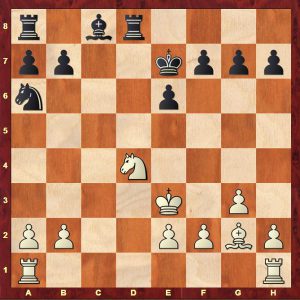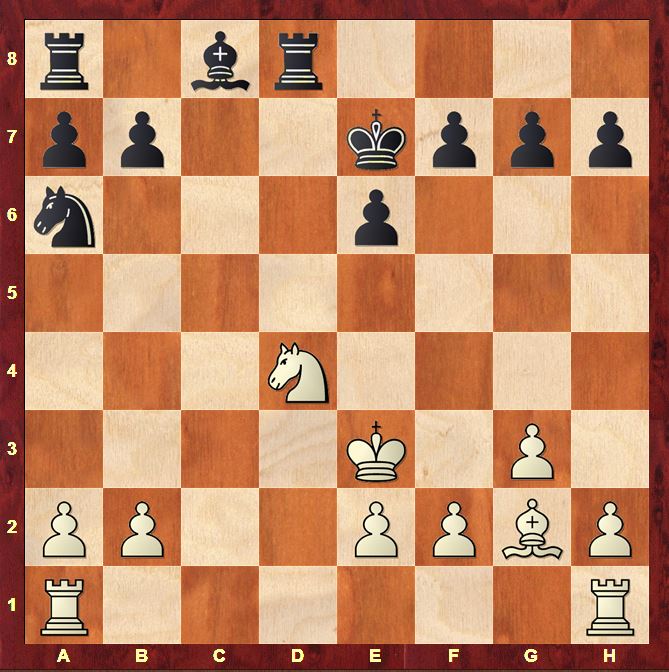While flicking through Alekhine’s collection of his Best Games, I came across this game against Euwe from the latter part of the 1937 World Championship Match. After an early exchange of queens, Alekhine won a pawn fairly quickly and I was intrigued to know where Euwe had gone wrong. As always, there were a couple of interesting moments to discover!
Alekhine,Alexander – Euwe,Max
World Championship 1937
1.Nf3 d5 2.c4 e6 3.d4 Nf6 4.Nc3 c5 5.cxd5 Nxd5 6.g3 cxd4 7.Nxd5 Qxd5 8.Qxd4 Qxd4 9.Nxd4 Bb4+ 10.Bd2 Bxd2+ 11.Kxd2 Ke7 12.Bg2 Rd8 13.Ke3 Na6

14.Rac1
This is the standard agonising practical choice: which rook should occupy the open file? Seeing however that White’s plan is to gain space by pushing his queenside pawns (in particular the b-pawn) and that a major source of counterplay for Black is initiated by …Nb4 (attacking the a-pawn on the way to d5) then 14.Rhc1 feels intuitively more precise than 14.Rac1. We’ll keep tabs on things in the coming moves to see whether that is indeed the case
14…Rb8
Euwe goes for a very long regrouping involving …Rb8, …Bd7–e8 and …Rd7 to bring the Na6 back into play with …Nc7
14…e5 is fairly sensible but turns out pleasantly for White after 15.Nb3 (15.Nb5 Bd7 16.a4 It would be so much nicer to have a rook on a1! (16.Nc7 Rac8 17.Nxa6 bxa6 should be reasonable for Black) 16…Rab8) 15…Rb8 16.Na5
15.a3
Imprecise – 15.f4 was now required to stop …e5. White might even then be threatening to play 16.b4 in one go as 16…Nxb4 17.Rb1 Nd5 18.Bxd5+ Rxd5 19.Nc6+ or 17…Nxa2 18.Nc6+ wins the exchange. Also after 16…Na6 17.Rhc1 Black is completely tied up. However since Black is likely to play 15…f6 or 15…Bd7 (which both render 16.b4 useless) this possibility is unlikely to happen!
15…Bd7
15…e5 16.Nb5 (16.Nb3 b6 is now possible when White’s knight has few prospects on b3) 16…Bd7 should be OK for Black.
16.f4 f6
16…Be8 was Black’s most consistent line. 17.b4 Rd7 18.Nb5 was given by Alekhine but it’s not as simple as he made out. After 18…Rdd8 19.Nxa7 Ra8, the clever 20.Nc8+ Raxc8 21.Rxc8 Rxc8 22.Bxb7 doesn’t work due to 22…Rc3+ 23.Kd2 Rxa3. Wouldn’t it be good to have a rook on a1?
I thought that this was Black’s best option but Stockfish found a very cunning idea:
20.b5 Rxa7 21.b6
So easy to miss! Now 21…Raa8 22.Bxb7 Rab8 23.Bxa6 Rxb6 24.Bd3 is better for White.
17.Be4
17.b4 is natural but 17…Rdc8 18.Rxc8 Rxc8 works for Black, again due to the loose pawn on a3!
17…Be8
Defending h7 tactically, but this asks too much of Black’s position. After 17…h6, White would have needed to build up his position further. Note that 18.b4 Rdc8 again works for Black due to the weakness of the pawn on a3 (19.Rxc8 Rxc8 20.Bxb7 Rc3+ 21.Kd2 Rxa3)
18.b4 Rd7 19.f5
White’s threats compel Black to give up the h7 pawn. Black fights hard, but it’s always an uphill struggle.
19…Nc7 20.fxe6 Nxe6 21.Nxe6 Kxe6 22.Bxh7 f5 23.Rc5 g6 24.Bg8+ Kf6 25.Rhc1 Re7+ 26.Kf2 Bc6 27.Bd5 Rbe8 28.Re1 Bxd5 29.Rxd5 g5 30.Rd6+ Ke5? 31.Red1 g4 32.R1d5+ Ke4 33.Rd4+ Ke5 34.Ke3 Re6 35.R4d5+ Kf6+ 36.Kf4 Kg6 37.Rxe6+ Rxe6 38.Re5 Ra6 39.Rxf5 Rxa3 40.Rb5! b6 41.Kxg4
1–0
So looking back, I think that the answer to the question on move 14 was that 14.Rhc1 was much stronger. We have seen a number of tactical variations where a rook on a1 protecting a pawn on a3 is the crucial factor in denying Black counterplay. For example: 14.Rhc1 Rb8 15.f4 Bd7 16.a3 Be8 17.b4 Rd7 18.Nb5 Rdd8 19.Nxa7 Ra8 20.Nc8+ Raxc8 21.Rxc8 Rxc8 22.Bxb7.
The difference with Rac1: …Rc3+xa3 defending the knight on a6 is no longer possible.
Postscript 29th October
Steve Giddins pointed out the similarity between this game and the 2nd Match game of the 1986 London-Leningrad Kasparov-Karpov match. Kasparov used a number of techniques that Alekhine applied against Euwe, in particular the manoeuvre Be4:
Kasparov,Garry – Karpov,Anatoly
World Championship London/Leningrad 1986
1.d4 Nf6 2.c4 e6 3.Nc3 Bb4 4.Nf3 c5 5.g3 Nc6 6.Bg2 d5 7.cxd5 Nxd5 8.Bd2 cxd4 9.Nxd4 Nxd4 10.Nxd5 Bxd2+ 11.Qxd2 Nc6 12.Nf4 Qxd2+ 13.Kxd2
13…Bd7 14.Rhc1 Ke7 15.Nd3 Rhc8 16.Nc5 Rab8 17.Rc3 Nd8 18.Rac1 Bc6 19.Nd3 Bd7 20.Ne5 Rxc3 21.Rxc3 Be8 22.b4 a6
23.Be4 h6 24.a3 f6 25.Nd3 Bc6 26.Bxc6 Nxc6 27.Nc5 Ne5 28.f4
28…Nd7 29.Nb3 Kd6 30.e4 g5 31.Ke3 e5 32.fxg5 fxg5 33.Na5 g4 34.Rc2 h5 35.Rc1 b6 36.Rc6+ Ke7 37.Nc4 Rf8 38.Ke2 Rf3 39.Ne3 Nf6 40.Rxb6 Nxe4 41.Rxa6 Rf2+ 42.Kd3 Nd6 43.Ra7+ Ke6 44.Rh7 e4+ 45.Kc3 Nb5+ 46.Kc4 Nxa3+ 47.Kd4 Rxh2 48.Rh6+ Kd7 49.Nd5 h4 50.Rxh4 Rxh4 51.gxh4 g3 52.Nf4 Nc2+
½–½




Matthew, excellent, very interesting piece, as always. I have one question though: at move 15, it what sense is b2-b4 threatened in one go (i.e. without a2-a3) after 15 f4? I can see why 15 f4 restrains Black’s e pawn, but not its ability to permit b2-b4.
Hi Allan, thanks for your comment! You are quite right: that wasn’t a very good comment of mine and I’ll correct it. The idea was that once you prevent the counterstroke …e5 driving away the knight from d4 with 15.f4, you might sometimes be able to play 16.b4 without preparation as 16…Nxb4 17.Rb1 Nd5 18.Bxd5+ Rxd5 19.Nc6+ or 17…Nxa2 18.Nc6+ wins the exchange. Also after 16…Na6 17.Rhc1 Black is completely tied up. However since Black is likely to play 15…f6 or 15…Bd7 (which both render 16.b4 useless) this possibility is unlikely to happen! I got a bit carried away looking for good reasons to play 15.f4! Best Wishes, Matthew
The other interesting thing about this game is the remarkable similarity to Kasparov-Karpov, Game 2, 1986 match (the London-Leningrad one). The opening transposed almost exactly and Kasparov played a very similar strategy, only failing to win because of a ridiculous blunder at move 40.
Hey Steve, that’s a really good spot. Indeed, Kasparov also uses the manoeuvre Be4 in that game too just like Alekhine. Can’t be coincidence! Best Wishes, Matthew